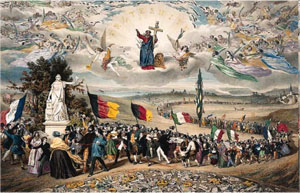1. A lithograph: “Die universelle demokratische und soziale Republik. Der Vertrag“; Frédéric Sorrieu
 Click image to enlarge
Click image to enlarge
Questions
Geographical/Historical Context
From 1820 onwards, Europe was shaken by a wave of revolutions, riots and conflicts, culminating in the revolutions of 1848 against the background of severe pan-European agricultural and economical crises. The conflicts concerned the reconstruction of the pre-revolutionary state system of Europe, restored in 1815, by nation state policies as well as the introduction of universal civil rights. People demanded stronger participation in political power, and the reconstruction of social structures necessitated by the change from agricultural to civil industrial society. In the second half of the 19th century, more than a few of these problems were answered by: the establishment of the Italian national state, the foundation of the German Empire and the enforcement of constitutional systems.
Frédéric Sorrieu (presumably born in 1807) was a French lithographer. His works depict in particular the events of the liberal and national revolutions in France and Europe. His best known works are the four lithographs about the “Universal, Democratic and Social Republic” of 1848, including the one depicted here, as well as “Le suffrage universel dédié à Ledru-Rollin” of 1850.
Answers to the questions
1. Where do you find the three central motives of the picture: freedom, fraternity and end of the old order?
An endless procession of the nations, represented by their flags, moves towards liberty (symbolically depicted as a statue). The symbols of the old order (monarchies) lie shattered on the ground. Christ hovers above them all as the embodiment of fraternity (fraternité): The blueprint of a holy alliance of all nations is presented as alternative draft to the Holy Alliance of the Christian rulers.
2. What is the meaning of the order of national flags?
Peoples like the Americans and the Swiss (right at the beginning of the procession) have already won liberty, France is just reaching it, while the other nations are still moving towards liberty. Germany (Allemagne) and Austria (Autriche) are depicted by separate flags, yet in the same colours. The Italian states are also represented by adequately many Italian flags.
3. What vision of the order of the world does Sorrieu have?
Sorrieu presents a utopia of a peaceful world order and friendship between nations all around the world: international solidarity, fight for freedom and social justice.




Presentation
The peoples are marching along the path of Freedom. The United States, Switzerland and France right at the front.